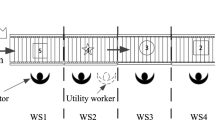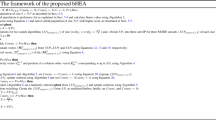Abstract
To solve the simple assembly line balancing problems of type 1 (SALBP-1), almost all of particle swarm algorithms (PSAs) for SALBP-1 adopt task sequence-oriented solution representation and are limited to the priority-based indirect encoding of feasible task sequence (FTS) so far. In this paper, firstly a novel FTS-oriented particle swarm algorithm (FTSOPSA) that directly records a FTS by a particle, named direct discrete PSA (DDPSA), is proposed to solve SALBP-1. In the DDPSA, a new multi-fragment crossover-based updating mechanism is developed, and the fragment mutation is incorporated into the DDPSA to improve exploration ability. Secondly, a systematic comparison of DDPSA and two existing FTSOPSAs as well as two existing genetic algorithms (GAs) has been presented against a set of instances selected from the literature and 15 randomly generated instances of SALBP-1. Comparisons between the FTSOPSAs and existing GAs show promising higher performance of the proposed DDPSA for SALBP-1, and also show that the direct encoding of FTS seems superior to the priority-based indirect encoding of FTS for solving SALBP-1.
Similar content being viewed by others
References
Scholl A, Becker C (2006) State-of-the-art exact and heuristic solution procedures for simple assembly line balancing. Eur J Oper Res 168(3):666–693. doi:10.1016/j.ejor.2004.07.022
Boysen N, Fliedner M, Scholl A (2007) A classification of assembly line balancing problems. Eur J Oper Res 183(2):674–693. doi:10.1016/j.ejor.2006.10.010
Tasan S, Tunali S (2008) A review of the current applications of genetic algorithms in assembly line balancing. J Intell Manuf 19(1):49–69. doi:10.1007/s10845-007-0045-5
Yu J, Yin Y (2010) Assembly line balancing based on an adaptive genetic algorithm. Int J Adv Manuf Technol 48(1):347–354. doi:10.1007/s00170-009-2281-7
Dou J, Dai X, Meng Z (2011) A ga-based approach for optimizing single-part flow-line configurations of rms. J Intell Manuf 22(2):301–317. doi:10.1007/s10845-009-0305-7
Mutlu Ö, Polat O, Ayca Supciller A (2013) An iterative genetic algorithm for the assembly line worker assignment and balancing problem of type-ii. Comput Oper Res 40(1):418–426. doi:10.1016/j.cor.2012.07.010
Fattahi P, Roshani A, Roshani A (2011) A mathematical model and ant colony algorithm for multi-manned assembly line balancing problem. Int J Adv Manuf Technol 53(1–4):363–378. doi:10.1007/s00170-010-2832-y
Rashid MFF, Hutabarat W, Tiwari A (2012) A review on assembly sequence planning and assembly line balancing optimisation using soft computing approaches. Int J Adv Manuf Technol 59(1–4):335–349. doi:10.1007/s00170-011-3499-8
Kennedy J, Eberhart R Particle swarm optimization. In: Proceedings of the IEEE International Conference on Neural Networks, Perth,Australia, 1995. Piscataway, NJ: IEEE Service Center, pp. 1942–1948
Salman A, Ahmad I, Al-Madan S (2002) Particle swarm optimization for task assignment problem. Microprocess Microsyst 26(8):363–371. doi:10.1016/S0141-9331(02)00053-4
Tasgetiren MF, Liang Y-C, Sevkli M, Gencyilmaz G (2007) A particle swarm optimization algorithm for makespan and total flowtime minimization in the permutation flowshop sequencing problem. Eur J Oper Res 177(3):1930–1947. doi:10.1016/j.ejor.2005.12.024
Rahimi-Vahed AR, Mirghorbani SM, Rabbani M (2007) A hybrid multi-objective particle swarm algorithm for a mixed-model assembly line sequencing problem. Eng Optim 39(8):877–898. doi:10.1016/j.cie.2007.06.007
Lv H, Lu C (2010) An assembly sequence planning approach with a discrete particle swarm optimization algorithm. Int J Adv Manuf Technol 50(5–8):761–770. doi:10.1007/s00170-010-2519-4
Tian Y, Liu D, Yuan D, Wang K (2013) A discrete pso for two-stage assembly scheduling problem. Int J Adv Manuf Technol 66(1–4):481–499. doi:10.1007/s00170-012-4343-5
Nearchou AC (2011) Maximizing production rate and workload smoothing in assembly lines using particle swarm optimization. Int J Prod Econ 129(2):242–250. doi:10.1016/j.ijpe.2010.10.016
Lu J, Jiang L, Li X (2009) Hybrid particle swarm optimization algorithm for assembly line balancing problem-2. In: Industrial Engineering and Engineering Management, 2009. IE&EM '09. 16th International Conference on 21–23 Oct. 2009. IEEE Press, pp. 979–983
Wang D, Zeng P, Li L, Wang K (2010) Assembly line balancing problem using particle swarm optimization algorithm. In: Intelligent Computing and Integrated Systems (ICISS), 2010 International Conference on, 22–24 Oct. 2010. IEEE Press, pp 629–632
Akyol SD, Bayhan GM (2011) A particle swarm optimization algorithm for maximizing production rate and workload smoothness. In: 2011 Third World Congress on Nature and Biologically Inspired Computing. IEEE Press, pp. 44–49
Lv Q (2011) Simple assembly line balancing using particle swarm optimization algorithm. Int J Digit Content Technol Appl 5(6):297–304
Raj MV, Sankar SS, Ponnambalam S (2012) Particle swarm optimization algorithm to maximize assembly efficiency. Int J Adv Manuf Technol 59(5–8):719–736. doi:10.1007/s00170-011-3512-2
Petropoulos DI, Nearchou AC (2011) A particle swarm optimization algorithm for balancing assembly lines. Assem Autom 31(2):118–129. doi:10.1108/01445151111117700
Hamta N, Fatemi Ghomi S, Jolai F, Akbarpour Shirazi M (2012) A hybrid pso algorithm for a multi-objective assembly line balancing problem with flexible operation times, sequence-dependent setup times and learning effect. Int J Prod Econ. doi:10.1016/j.ijpe.2012.03.013
Chutima P, Chimklai P (2012) Multi-objective two-sided mixed-model assembly line balancing using particle swam optimisation with negative knowledge. Comput Ind Eng 62(1):39–55. doi:10.1016/j.cie.2011.08.015
Kennedy J, Eberhart RC A discrete binary version of the particle swarm algorithm. In: 1997 I.E. International Conference on Computational Cybernetics and Simulation, Orlando, FL, USA 1997. IEEE Press, pp. 4104–4108
Dou J, Su C, Li J A discrete particle swarm optimization algorithm for assembly line balancing problem of type 1. In: 2011 Third International Conference on Measuring Technology and Mechatronics Automation (ICMTMA 2011), Shanghai, 2011. IEEE Press, pp. 44–47
Dou J, Li J, Lv Q A hybrid particle swarm algorithm for assembly line balancing problem of type 1. In: Mechatronics and Automation (ICMA), 2011 International Conference on, Beijing, 7–10 August 2011 2011. IEEE Press, pp. 1664–1669
Rubinovitz J, Levitin G (1995) Genetic algorithm for assembly line balancing. Int J Prod Econ 41(1–3):343–354. doi:10.1016/0925-5273(95)00059-3
Levitin G, Rubinovitz J, Shnits B (2006) A genetic algorithm for robotic assembly line balancing. Eur J Oper Res 168(3):811–825. doi:10.1016/j.ejor.2004.07.030
Baybars I (1986) A survey of exact algorithms for the simple assembly line balancing problem. Manag Sci 32(8):909–932
Shi Y, Eberhart R (1998) A modified particle swarm optimizer. In: Proceedings of the IEEE international conference on evolutionary computation. IEEE Press, NJ, pp. 69–73
Kennedy J, Eberhart RC, Shi Y (2001) Swarm intelligence. Morgan Kaufmann, San Mateo
Poli R, Kennedy J, Blackwell T (2007) Particle swarm optimization: an overview. Swarm Intelligence 1:33–57. doi:10.1007/s11721-007-0002-0
Gen M, Cheng RW (2000) Genetic algorithms and engineering optimization. Wiley, New York
Sabuncuoglu I, Erel E, Tanyer M (2000) Assembly line balancing using genetic algorithms. J Intell Manuf 11(3):295–310. doi:10.1023/A:1008923410076
Moumene K, Ferland JA (2008) New representation to reduce the search space for the resource-constrained project scheduling problem. RAIRO-Oper Res 42(02):215–228. doi:10.1051/ro:2008010
Watchanupaporn O, Suwannik W (2010) An estimation of distribution algorithm using the lzw compression algorithm. In: the COGNITIVE 2010, The Second International Conference on Advanced Cognitive Technologies and Applications, pp. 97–102
Suwannik W (2011) Lzw encoding in genetic algorithm. Int J Appl Evol Comput 2(4):25–36. doi:10.4018/jaec.2011100102
Goncalves JF, de Almeida JR (2002) A hybrid genetic algorithm for assembly line balancing. J Heuristics 8(6):629–642. doi:10.1023/A:1020377910258
Nicosiaa G, DarioPacciarelli PA (2002) Optimally balancing assembly lines with different workstations. Discret Appl Math 118:99–113. doi:10.1016/S0166-218X(01)00259-1
Shi Y, Eberhart R (1998) Parameter selection in particle swarm optimization. In: Proceedings of the 7th International Conference on Evolutionary Programming VII, 1998. Springer, Berlin Heidelberg, pp. 591–600
Author information
Authors and Affiliations
Corresponding author
Rights and permissions
About this article
Cite this article
Dou, J., Li, J. & Su, C. A novel feasible task sequence-oriented discrete particle swarm algorithm for simple assembly line balancing problem of type 1. Int J Adv Manuf Technol 69, 2445–2457 (2013). https://doi.org/10.1007/s00170-013-5216-2
Received:
Accepted:
Published:
Issue Date:
DOI: https://doi.org/10.1007/s00170-013-5216-2




